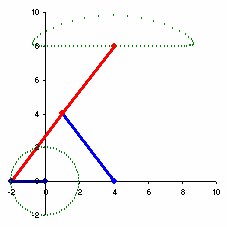|
7. HOEKENS LINKAGE
|
||
|
The Inventor(s)
I have been unable to discover any detail of the so-called inventor of this linkage. The linkage belongs to a class of linkages known as Grashof crank-rockers. It may be that Hoekens’ (Hoeken’s?) linkage was discovered first and then generalized by Grashof, or perhaps Hoekens found that this example of the Grashof crank-rockers was particularly useful. We do have some information about Franz Grashof. He was a German engineer who lived from 1826 to 1893. He was a professor of Applied Mechanics at the Technischen Hochschule Karlsruhe, and was one of the founding directors of Verein Deutscher Ingenieure (VDI) in 1855. He developed some early steam-flow formulas, and is remembered for the Grashof Number and the Grashof Condition. After his death, the Association of German Engineers (VDI) honored Grashof’s memory by instituting the Grashof Commemorative Medal as the highest distinction that the society could bestow for merit in the engineering skills. We observe that Grashof lived in the time when linkages were being actively developed. The Linkage The Hoekens linkage is a four bar mechanism that converts rotational motion to approximate straight-line motion. The figure at right is an animated gif file which appears in Wikipedia (see reference below). As shown in the animation, good values for the lengths of the linkage segments are 1, 2 (blue), 2.5 and 2.5 (red). The Mathematics Mathematical analysis of this linkage appears to be difficult. Numerical methods can be used to choose linkage lengths to optimize the straightness of the horizontal segment, or to optimize the constancy of the velocity along this segment. These do not occur for the same linkage lengths.
Bibliography |
||
|
|
